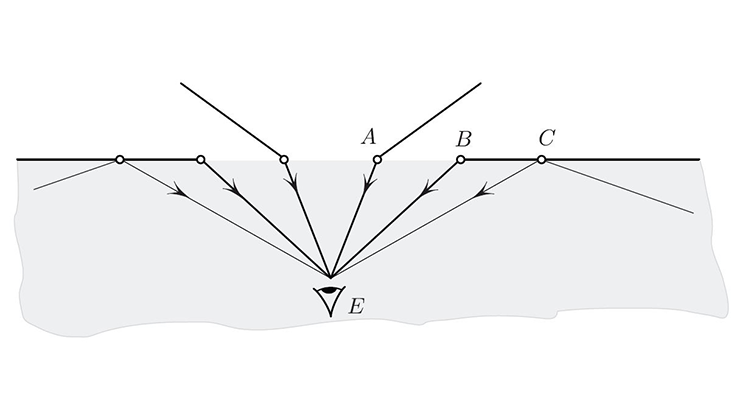A Mirage on the Road and the Poincaré Metric
Here I present a few miscellaneous observations prompted by the boredom of a long drive on a sunny summer day.
Estimating the Temperature of a Hot Highway Surface from the Distance to a Mirage
With unabashed departure from reality, I assume a perfectly flat highway and an air temperature that is solely dependent on height. The hot air near the asphalt is less dense and supports a higher speed of light. According to Fermat’s principle, light picks the path of least time; it is therefore beneficial for the rays to bend towards the highway, where they travel faster and save time (see Figure 1). With the temperature—and thus the speed of light—depending only on height, Snell’s law (derivable from Fermat’s principle) applies. According to this law, the sine of angle \(\theta\) between the tangent to the ray and the vertical varies along any ray in direct proportion to the speed of light:
\[\sin \theta /c = {\rm const.} \tag1 \]
We can roughly estimate the index of the hot air’s refraction at the hot road surface. Let \(B\) in Figure 1 be the farthest point on the road surface from the eye \(E\) that is still visible to \(E\). The ray \(BE\) is hence tangent to the road at \(B\), so that \(\theta _B= \pi /2\). By Snell’s law, \(\sin \theta_{\rm E} /c_E = \sin \theta_B/ c_B = 1/ c_B\), so that the indices of refraction (the reciprocals of the speed of light) satisfy
\[n_B= n_E\sin \theta_E. \tag2 \]
We can now eyeball \(\sin \theta_E\) as the ratio of \(E\)'s height to distance \(EB\), and thus estimate \(n_B/n_E\). This ratio is a monotone function of the road’s temperature, which one can therefore estimate in principle.

Interestingly, the way in which \(c\) depends on height does not affect angle \(\theta_E\); only the values of \(c\) at the ray’s endpoints matter. Of course, all of this is highly idealized due to the assumptions established at the outset.
Rays Near the Road and the Poincaré Metric

Assuming the speed of light \(c\) to be a linearly decreasing function of height (presumably not too unreasonable an assumption for a small strip near the hot road surface), what is the shape of the rays? By Fermat’s principle, a ray traveling between two points picks the path \(\gamma\) that minimizes1 travel time \(\int_{ \gamma } dt= \int_{ \gamma } ds/c\). Using dilation and translation, we can achieve \(c(y)= y\) up to a constant factor; \(y\) measures the (rescaled) downward distance from some horizontal line above the ground (see Figure 2). This is the line where \(c\) would have vanished if the speed of light had continued its decrease with increasing height beyond the narrow strip near the road surface. We choose the line \(c=0\) as the zero level and count the distance \(y\) downwards from it.
The travel time along \(\gamma\) is \(\int_{ \gamma } ds/y\), up to the scaling factor. This is precisely the length of \(\gamma\) in the Poincaré metric \(ds/y\)! The Poincaré metric is thus the simplest imaginable non-Euclidean metric, corresponding to the simplest non-constant speed of light: linear function \(c(x,y) = \alpha x + \beta y\), reducible to \(c(y)=y\) by rotation and dilation.
Why are the Poincaré Geodesics Circular?
Consider an arbitrary ray with the speed of light \(c=c(y)=y\); the ray satisfies Snell’s law \((1)\). Let us presumptuously denote the constant in the right-hand side of \((1)\) by \(R ^{-1}\), so that our ray satisfies
\[\frac{\sin \theta }{y} = \frac{1}{R}, \ \ \ \hbox{i.e.}, \ \ \ R \sin \theta = y.\]
But a semicircle of radius \(R\) centered at a point on the line \(y=0\)—as in Figure 2—satisfies the exact same relationship as the ray. Now this relationship is a first-order ordinary differential equation in disguise for the function \(y = y(x)\), where \(x\) is the horizontal coordinate. According to the uniqueness theorem, our ray coincides with the semicircle that shares a point and a tangent to the ray at that point. We have thus shown that Poincaré geodesics/light rays are semicircular arcs centered at the zero velocity line.
As a concluding remark, the upside-down counterpart of internal reflection of the highway mirage is the internal reflection observed by divers (see Figure 3).

1 More precisely, the path is a minimum of the time functional only if there are no conjugate points along the ray connecting the two points. For \(c(y)= y\), this no-conjugate-points condition automatically holds for any pair of endpoints (the Poincaré metric has negative curvature) [1].
The figures in this article were provided by the author.
References
[1] Levi, M. (2014). Classical Mechanics with Calculus of Variations and Optimal Control: An Intuitive Introduction. In Student Mathematical Library (Vol. 69). Providence, RI: American Mathematical Society.
About the Author
Mark Levi
Professor, Pennsylvania State University
Mark Levi (levi@math.psu.edu) is a professor of mathematics at the Pennsylvania State University.
Stay Up-to-Date with Email Alerts
Sign up for our monthly newsletter and emails about other topics of your choosing.



